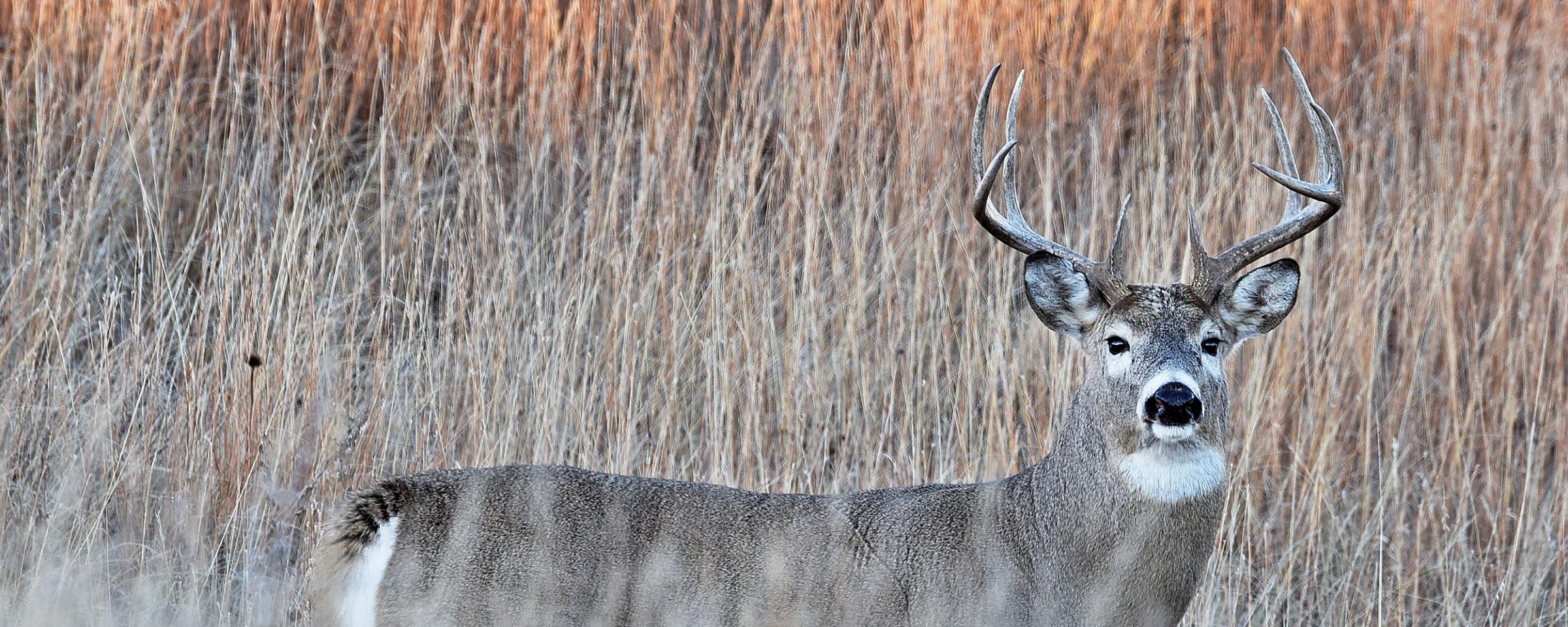
2018 Year in Review
North Dakota Game and Fish Department personnel spent a considerable amount of time in 2018 thinking more strategically about agency priorities and how the Department manages the state’s fish and wildlife resources.
One of the components of that process is identifying the Department’s key drivers and performance indices. Key drivers are those elements that have the most impact on how we deliver services and includes customer base, fish and wildlife populations, access, habitat and so on.
Key performance indices are elements of Game and Fish business that are measurable, such as license sales, hunter and angler success rates and overall hunter and angler satisfaction.
The biggest challenges for state wildlife managers are those things over which we have no control, including weather and the federal farm bill. Knowing this, we will continue to focus on those components we are able to influence to benefit our resources.
Wildlife populations in 2018 covered both ends of the spectrum. Deer populations, particularly mule deer, continued to do fairly well, following some difficult winters and declining numbers. Whitetail numbers, while on an upward trend, are still a bit below Department goals for most hunting units.
North Dakota’s pheasant population is still feeling the negative effects of a significant reduction in grassland habitat due to expiring Conservation Reserve Program acres over the past decade and drought in 2017.
While fishing opportunities are still plentiful across the state, the drier weather pattern the last couple of years has had some influence on some of our marginal fishing lakes.
The number of fishing waters managed by Game and Fish personnel in recent years peaked at about 450 lakes, but that number dwindled a bit in the last year due to dropping water levels on some lakes.
North Dakota has several smaller walleye lakes managed by the Department that are on the verge of producing some good fishing opportunities if Mother Nature cooperates.
While I, like a lot of North Dakotans, really like mild winters, we will need some meaningful precipitation at some point to replenish our wetland base.
A recent confirmation of chronic wasting disease in a mule deer shot during the 2018 deer gun season in northwestern North Dakota has spurred lots of discussion about what this will ultimately mean for deer management strategies moving forward.
Prior to this, CWD was found only in the southwestern part of the state in deer hunting unit 3F2. However, the disease is rather prevalent in Saskatchewan, so while this news is disappointing to state wildlife managers and hunters in northwestern North Dakota, it is not entirely surprising.
Knowing that CWD has made its way into northwestern North Dakota, we’ll likely have to manage that area like we do in the southwestern part of the state. Which means a baiting ban to help keep deer from artificially congregating and potentially spreading the disease.
Game and Fish Department personnel have started preparing for another legislative session in 2019. As in the past, we are hearing about certain bills that have the potential to be introduced and early indications point to a busy session.
We will know soon how many game and fish related bills are introduced and what sort of an impact, be it positive or negative, they may have on the way we deliver services to our customers. As always, we will be tracking bills that affect our agency and our customers and will provide regular updates on the Department’s website and other media outlets.
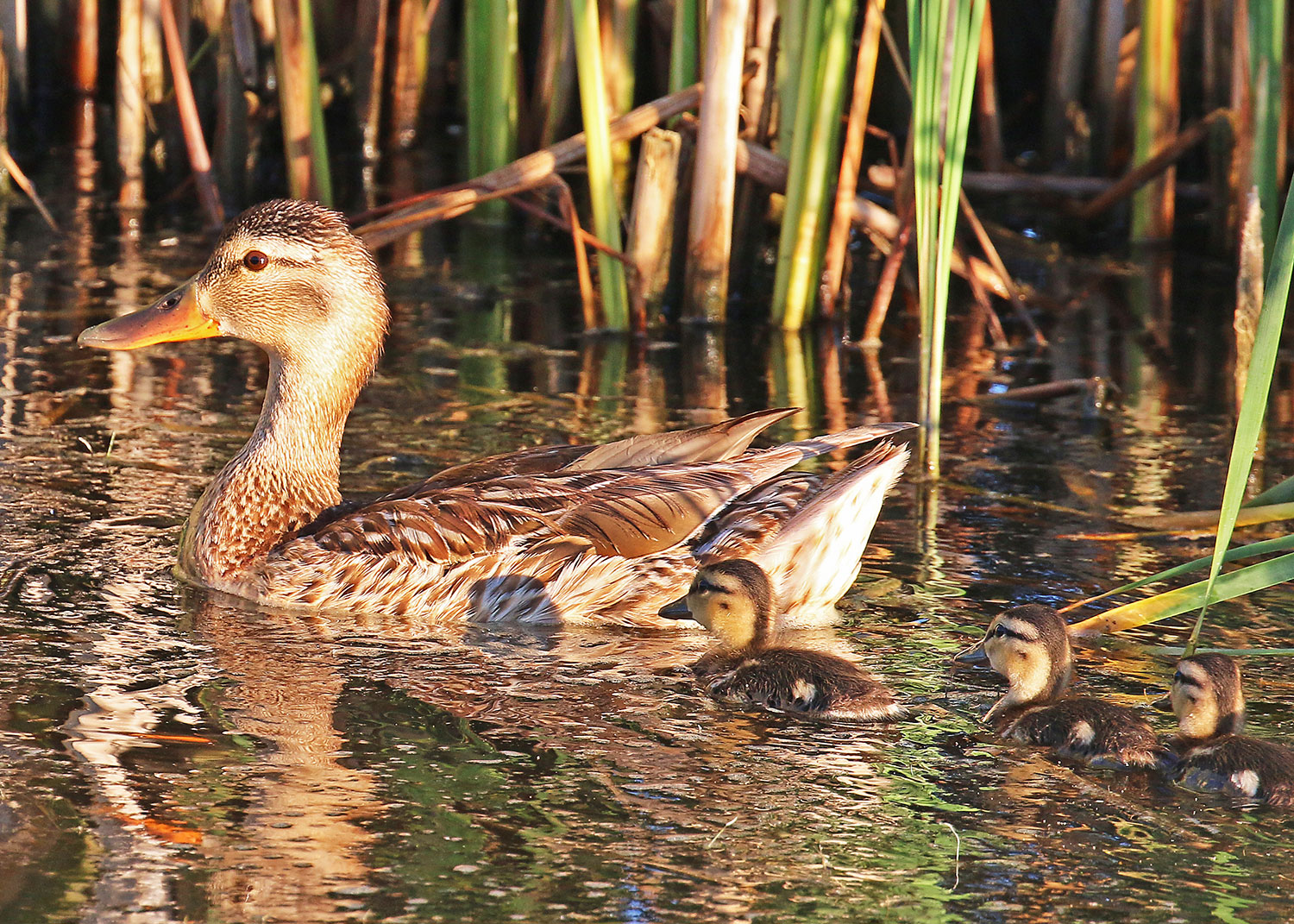
The number of duck broods observed in summer 2018 was up 37 percent from 2017.
Upland Birds and Waterfowl
North Dakota’s roadside surveys indicated total pheasant and Hungarian partridge numbers in 2018 were similar to 2017, while sharp-tailed grouse numbers were down.
The survey showed total pheasants observed per 100 miles was down 2 percent from 2017. In addition, broods per 100 miles were unchanged, while the average brood size was up 27 percent. Department biologists said that even though survey data suggested pheasant production was better than 2017, hunters would notice the lack of production from 2017 in the overall population.
The survey indicated that sharptails observed were down 49 percent statewide from 2017, while partridge were up 7 percent.
Declining wetland conditions, but good waterfowl numbers were found during the Game and Fish Department’s 71st annual spring breeding duck survey. However, wetland conditions across much of the state made a quick turn-around following abundant late spring and early summer rains.
The number of duck broods observed during the Department’s July brood survey was up 37 percent from 2017, and 77 percent above the long-term average. The average brood size of 6.76 ducklings was nearly identical to 2017.
Numbers of resident Canada geese, Western Prairie Canada geese and arctic nesting Tallgrass Prairie Canada geese, snow geese and Ross’s geese all remained high.
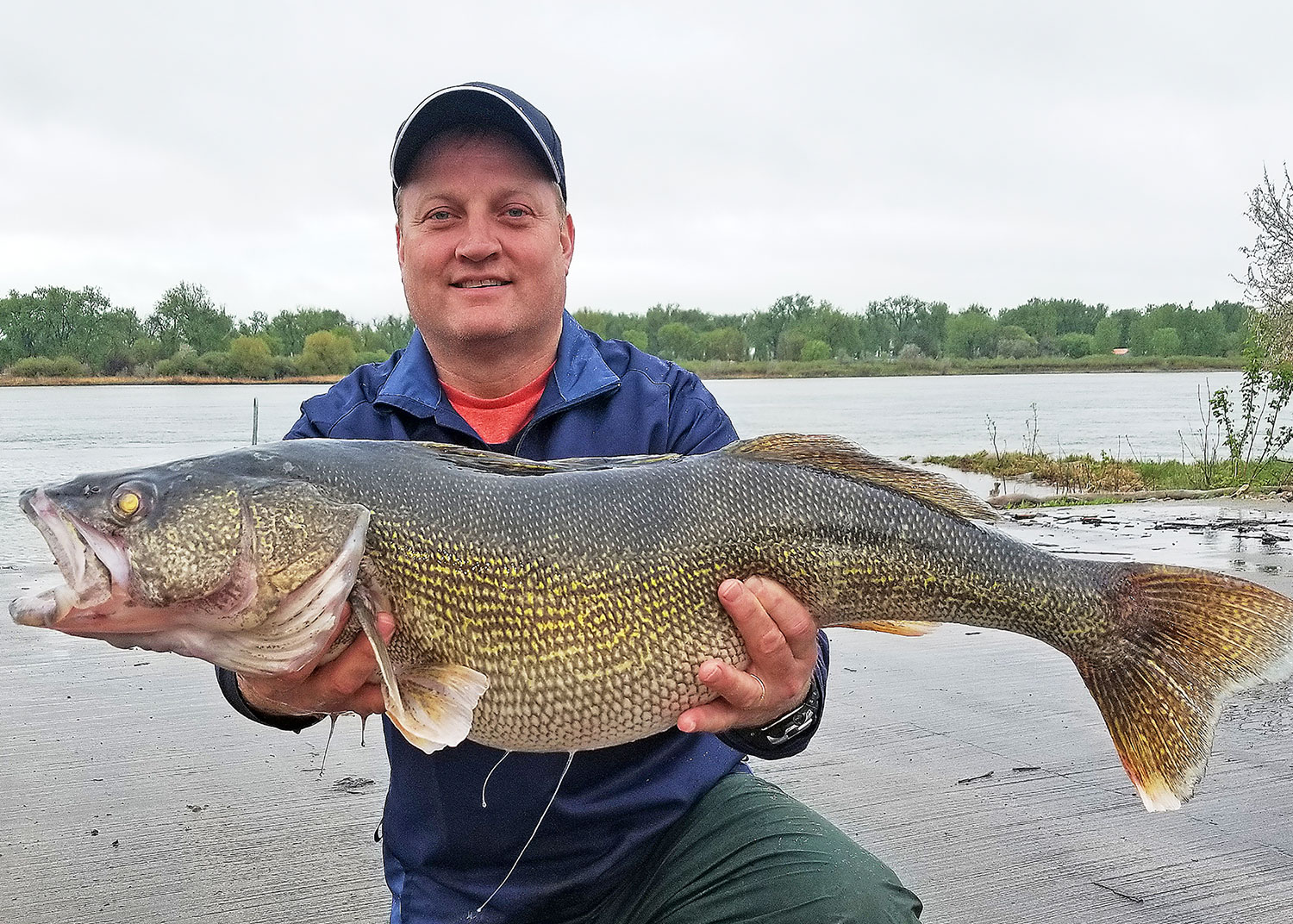
Neal Leier of Bismarck with the state’s new record walleye.
Record Walleye
Given the recent history of good water conditions in lakes Sakakawea and Oahe, and the section of the Missouri River sandwiched between, Game and Fish Department fisheries managers weren’t surprised that a new state record walleye was caught in the river near Bismarck.
Neal Leier of Bismarck caught the 15-pound, 13-ounce walleye on a rainy Friday near the Fox Island boat ramp. He jigged his plastic bait maybe five times before hooking into what felt like a log when he got the fish on the reel.
Leier’s walleye broke the old state record, a 15-pound, 12-ounce walleye from Wood Lake in Benson County, by just an ounce. The Wood Lake walleye record stood for nearly 60 years.
Fall Fish Surveys
The Game and Fish Department’s fall fish reproduction survey, which evaluates natural reproduction, stocking success and forage abundance, indicated that most waters fared as good as or better than expected in 2018.
Lake Sakakawea had the eighth highest catch of young-of-the-year walleye on record. There was also good reproduction of most game species in the big lake, as fisheries biologists saw healthy numbers of pike, perch, smallmouth bass, white bass, crappies and walleye. Plus, it was the second year in a row of good walleye reproduction, which wasn’t a surprise considering the high water resulted in an abundance of food and habitat for the young fish.
Lake Oahe showed good reproduction of walleye in 2018, which wasn’t necessarily a good thing, considering that Oahe is still lacking forage that fish need to grow.
Devils Lake saw fair to good numbers of walleye, with the catch close to average even though Game and Fish didn’t stock any walleye in the fishery in 2018. The end result was all from natural reproduction.
Sampling results on smaller lakes generally varied from lake to lake. The common theme mentioned by fisheries personnel across the state in 2018 was that young-of-the-year fish were larger than normal. This is significant because bigger fish generally have a better chance of surviving through the first winter and that’s an important step in getting those fish to a catchable size in the future.
Aquatic Nuisance Species
North Dakota did not have any new aquatic nuisance species discoveries in 2018. That includes movement of ANS that are already in the state, or documentation of new species.
Fisheries managers said that North Dakota is fortunate to this point to have few problems with ANS. Game and Fish ANS educational efforts and cooperation of North Dakota anglers, boaters and hunters has helped in the effort to safeguard the state’s waters.
Deer License Numbers Up
The Game and Fish Department made available 55,150 licenses to deer gun hunters in 2018.
That was good news because that was 650 more licenses than 2017 and well above the recent low of 43,275 in 2015.
Some of the increases in deer gun licenses were seen in both antlered mule deer (up 150) and antlered whitetails (up 150).
Deer Gun Apps Go Electronic
For the first time in 2018, all hunters who applied for a deer gun license had to do so electronically.
The Game and Fish Department’s plan to move all lottery applications online was initiated in 2016 after lawmakers passed a law requiring the Department to phase out the old paper license books and develop an all-electronic licensing system.
This all-electronic plan for deer gun hunters wasn’t a giant leap as thousands of hunters had already applied electronically for swan, turkey, moose, elk and bighorn sheep licenses prior to the deer gun lottery.
Game and Fish also initiated a concentrated effort in 2018 to remind deer hunters of a state law that required them to purchase a general game and habitat license before they could receive a deer license in the mail.
In 2017, about 5,500 hunters who drew a deer license did not purchase a general game and habitat license. In 2018, that number was cut to about 500, and those potential hunters did not receive their tags in the mail.
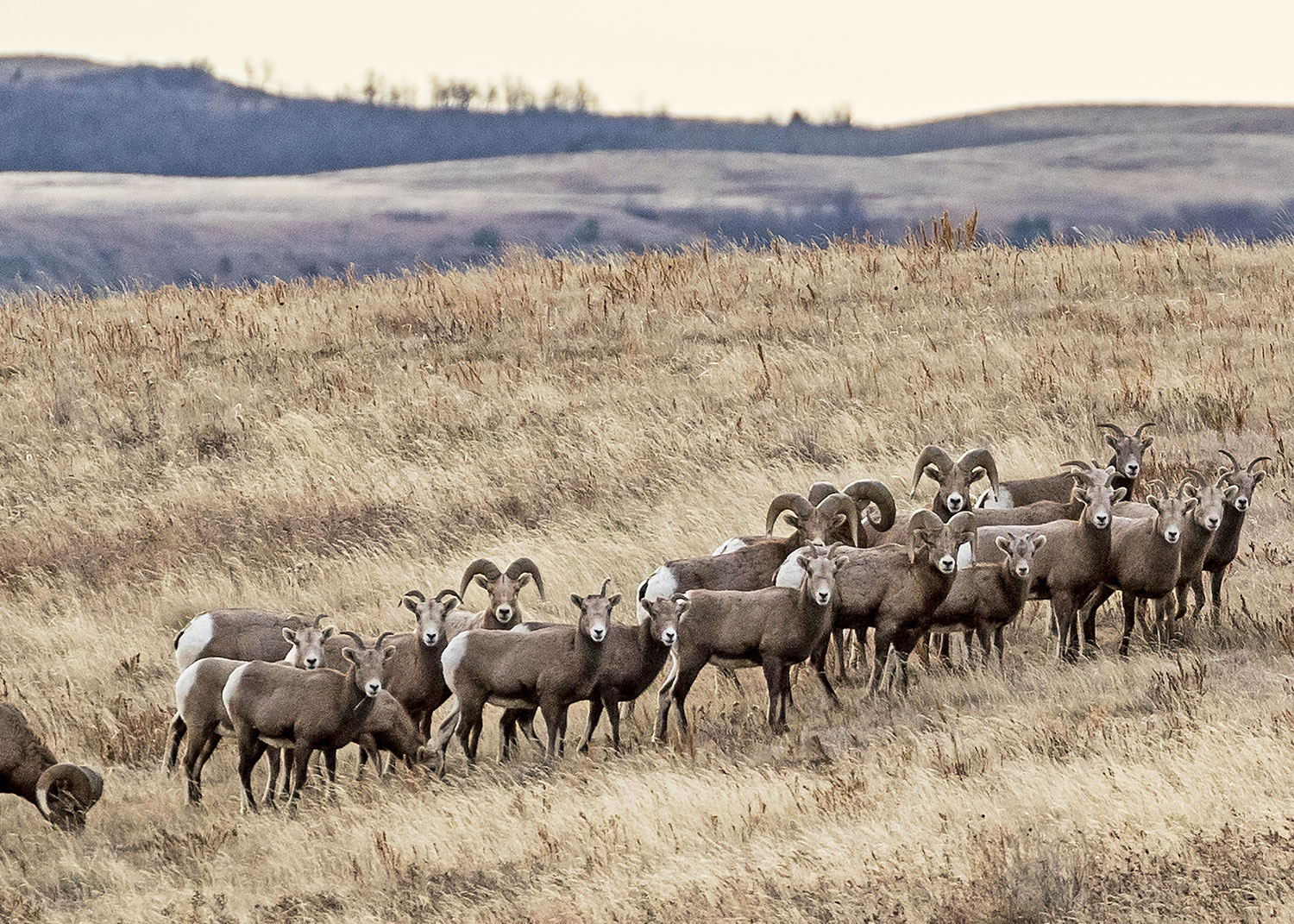
An outbreak of bacterial pneumonia that was first detected in 2014 continues to negatively influence North Dakota’s bighorn sheep population.
Bighorn Sheep Decline, Hunting Licenses Follow
The Game and Fish Department allocated three bighorn sheep licenses for the 2018 hunting season, two fewer than in 2017.
One license, as authorized under North Dakota Century Code, was auctioned in spring by the Midwest Chapter of the Wild Sheep Foundation, from which all proceeds are used to enhance bighorn sheep management in North Dakota.
The number of once-in-a-lifetime licenses allotted to hunters was based on data collected from the Department’s summer population survey. Results of the survey showed a total of 77 rams, 12 fewer than 2017 and 27 fewer than 2016.
Big game biologists said the 13 percent decline in ram numbers was likely the result of an ongoing bacterial pneumonia outbreak that was first detected in 2014.
In addition, 2017 had the second lowest lamb recruitment on record so only four yearling rams were observed. Encouragingly, no adult animals within the herds that were exposed to disease in 2014 showed clinical signs of pneumonia, and the summer lamb count in those herds improved.
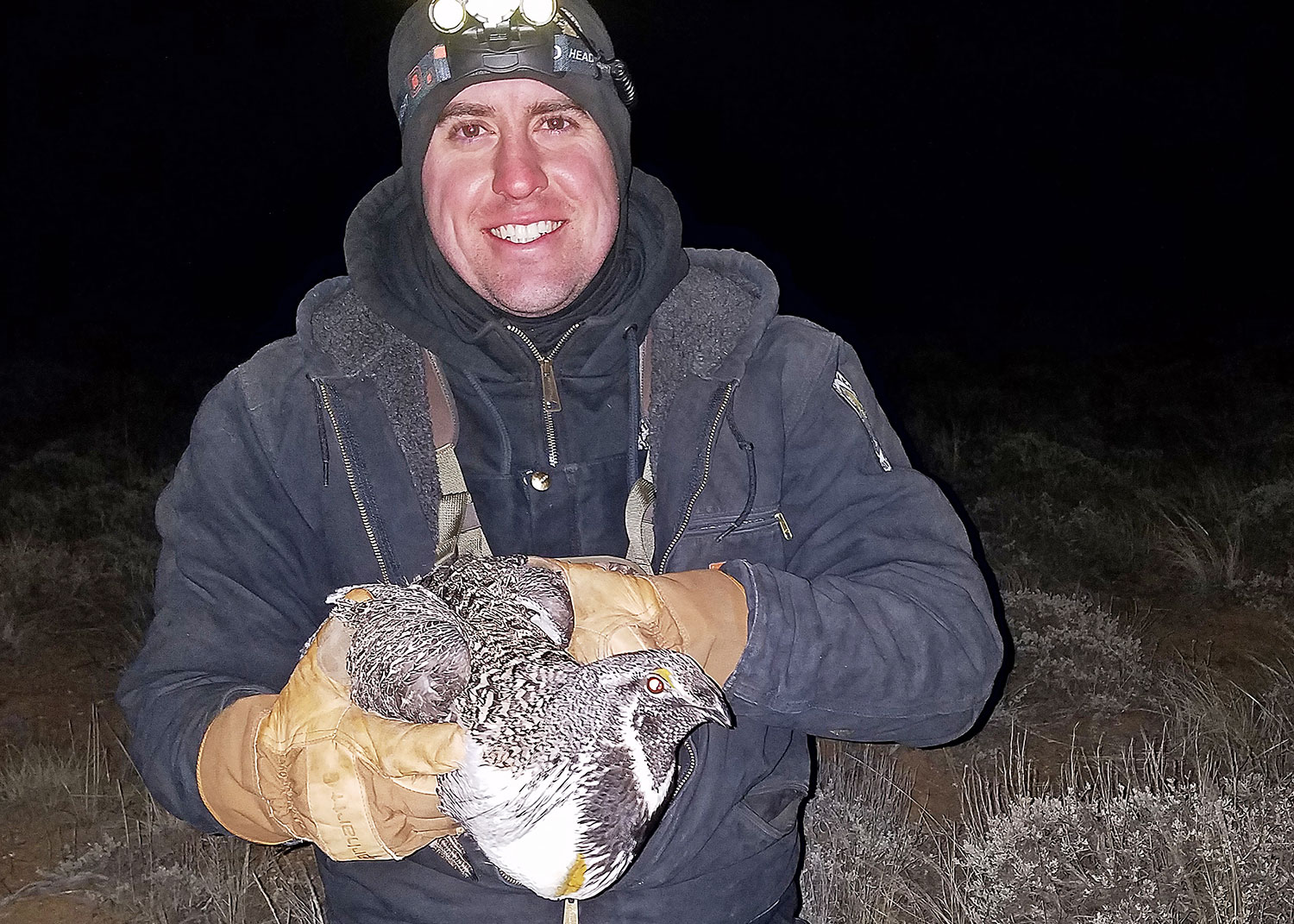
Brandon Ramsey, Game and Fish Department wildlife technician, with an adult sage grouse captured in Wyoming in 2018.
Sage Grouse Translocation Efforts Continue
Efforts to bolster a declining sage grouse population in southwestern North Dakota continued in 2018, but with a twist.
In 2017, state wildlife managers translocated 60 sage grouse – 40 females and 20 males – from southern Wyoming to Bowman County. Researchers marked all birds with GPS and VHF radio devices to monitor survival, movements and habitats selected.
In spring 2018, 39 sage grouse, with a near equal divide in sexes, were captured in Wyoming, fitted with tracking devices, and released south of Marmarth.
The twist was that 20 additional sage grouse hens were captured in Wyoming and released back into the population, with the aim of recapturing and translocating adults and their young to North Dakota after successful nesting.
The reasoning behind the brood translocations, biologists said, was to see if this method increased recruitment, reduced movements and fostered site fidelity in the new population. While the sample size was small, the results late last summer and early fall were encouraging as the adult hens and young were sticking around the areas at which they were released.
Canada Goose Hunting Zones Restructured
The Game and Fish Department restructured the state’s Canada goose hunting zones in 2018.
According to Game and Fish waterfowl managers, the move was made to further help address overabundant Canada geese and provide extra hunting opportunities in September, without taking away quality late-season hunting opportunities.
Under the new structure, there are now three zones – Missouri River, western and eastern – instead of two. Early Canada goose hunting opportunities opened August 15 in all zones, but closed on different dates, the latest being September 21 in the eastern zone.
Also, the regular Canada goose season closed in the eastern zone earlier in December than the other two zones.
Basically, more Canada goose-landowner conflicts are in the eastern half of the state and getting those extra days back in September would put some more harvest pressure on those birds. At the same time, that part of the state doesn’t have reliable, consistent hunting opportunities late into December.
Fall Mule Deer Survey
The Department’s fall mule deer survey indicated fawn production in 2018 was better than in 2017.
Biologists counted 2,446 mule deer in the aerial survey in October. The buck-to-doe ratio of 43 bucks per 100 does was higher than last year and the same as the long-term average. The mule deer fawn-to-doe ratio was 84 fawns per 100 does, which was higher than 2017, but slightly lower than the long-term average of 89 fawns per 100 does.
Big game biologists said mule deer fawn production has been on a positive trend since 2013, following record low fawn production after the winters of 2008-09 through 2010-11. Mule deer fawn-to-doe and buck-to-doe ratios were at or near their long-term averages in all management regions except the northern badlands, which includes hunting unit 4A.
Walleye Stocking
Fisheries personnel stocked nearly 10 million walleye fingerlings in more than 140 waters across the state in 2018.
Considering not many went into Lake Sakakawea, 2018 featured one of the largest stockings of more than 8 million fingerlings into smaller fishing waters.
With more than 50 new walleye lakes in North Dakota, the demand to stock those waters, along with the larger, traditional fisheries, greatly increased the demand from the hatcheries.
Conditions at the lakes were very good, with cool water temperatures and in some cases, newly flooded vegetation from rainfall. It was expected that the fingerlings should have found lots of food and good survival conditions.
CWD Surveillance Continued
The Game and Fish Department continued its Hunter-Harvested Surveillance program during the 2018 hunting season, by sampling deer for chronic wasting disease and bovine tuberculosis from 17 units in the western portion of the state. In addition, all moose and elk harvested in the state were eligible for testing.
Samples from hunter-harvested deer were tested from units 3A1, 3A2, 3A3, 3B1, 3B2, 3D1, 3D2, 3E1, 3E2, 3F1, 3F2, 4A, 4B, 4C, 4D, 4E and 4F.
Test results indicated that two deer tested positive for CWD in hunting unit 3F2 and one deer tested positive in hunting unit 3A1.
The results in 3F2 weren't surprising to biologists as deer have tested positive in that hunting unit in the past. The same could be said for 3A1 in northwestern North Dakota where deer across the border in Canada have tested positive with the disease.
2018 Figures
- 3 – Number of bighorn sheep licenses allocated to hunters, two fewer than 2017.
- 10 – Number of pronghorn hunting units open in 2018, five more than 2017. Pronghorn hunting seasons were closed 2010-13 as animal numbers drastically declined following severe winters.
- 15 pounds, 13 ounces – The weight of the new state record walleye caught May 18 in the Missouri River.
- 24 – Age of the oldest known walleye ever taken from Lake Sakakawea. Department fisheries biologists confirmed its age in 2018 by counting the age rings on a magnified image of an otolith, or ear bone.
- 29 pounds, 2 ounces – Weight of the biggest northern pike fisheries biologists tagged in the Missouri River System in 2018 as part of an ongoing study to determine how anglers utilize trophy fish. The big female pike measured 44.5 inches long.
- 30 – The percentage decline in the state’s spring pheasant population index compared to 2017.
- 39 – Number of sage grouse captured in Wyoming, fitted with tracking devices and released in southwestern North Dakota, in an ongoing effort to bolster a fading grouse population in the state.
- 450 – Approximate number of fishing waters in North Dakota that have public access and some degree of management by Department fisheries biologists.
- 600 – Number of student archers who competed in the North Dakota National Archery in the Schools Program in Minot. A record 750 students registered for the event, but a spring snowstorm kept some from attending.
- 2,540 – Number of mule deer counted during the Department’s spring survey. Survey results were 45 percent above the long-term average.
- 11,000 – Number of hunters who applied for 1,075 pronghorn licenses in 10 hunting units.
- 55,150 – Number of deer gun licenses made available to hunters, up 650 licenses from 2017.
- 135,000 – Estimated number of Canada geese counted during the Department’s annual midwinter waterfowl survey.
- 762,000 – Approximate number of Private Land Open To Sportsmen acres available for the fall hunting season.
- 2.2 million – Number of salmon eggs collected by fisheries crews. The majority of the eggs were collected from salmon from Lake Sakakawea.
- 10 million – Estimated number of walleye fingerlings stocked in 140 waters across the state.
| 2017-18 LICENSES AND PERMITS ISSUED | ||
|---|---|---|
| Resident | Nonresident | |
| Individual Fishing | 53,821 | 19,093 |
| Husband/Wife Fishing | 14,676 | 5,277 |
| Senior Citizen Fishing | 12,501 | |
| Disabled Fishing | 285 | |
| Short-Term Fishing | ||
| 10-Day | 7,649 | |
| 3-Day | 25,702 | |
| Paddlefish Tags | 2,719 | 707 |
| Commercial Tags | 17 | |
| Retail Bait Vendor | 302 | |
| Wholesale Bait Vendor | 36 | 8 |
| Fish Hatchery | 4 | |
| 2017 Boat Registrations (First year of 3-year decal) | 59,048 | |
| General Hunting | 37,995 | 37,243 |
| Small Game Hunting | 15,243 | 19,255 |
| Combination License | 55,954 | |
| Waterfowl Hunting | 20,770 | |
| Furbearer Hunting/Trapping | 10,721 | 3,153 |
| Fur Buyer | 36 | 9 |
| Deer Gun Hunting | 40,438 | 300 |
| Deer Gun Hunting (Gratis) | 13,402 | 264 |
| Deer Bowhunting | 26,109 | 2,367 |
| Moose Hunting | 210 | |
| Moose Hunting (Preferential Landowner) | 35 | |
| Elk Hunting | 328 | |
| Elk Hunting (Preferential Landowner) | 71 | |
| Turkey Hunting (Spring) | 5,457 | |
| Turkey Hunting (Fall) | 3,303 | 26 |
| Turkey Hunting (Gratis Spring) | 324 | |
| Turkey Hunting (Gratis Fall) | 195 | |
| Habitat Stamp | 75,039 | |
| Shooting Preserve | 10 | |
| Fishing/Hunting Guide | 273 | 31 |
| Taxidermist | 226 | 9 |
| Falconry | 8 | |
| Scientific Collector | 34 | 18 |
| Swan | 1,601 | 1,099 |
| Sandhill Crane | 2,262 | 1,745 |
| 2018 SPECIAL BIG GAME LICENSES | ||
| LICENSES AVAILABLE | APPLICATIONS RECEIVED | |
| Moose | 330 | 21,041 |
| Elk | 404 | 18,082 |
| Bighorn Sheep | 3 | 14,615 |
| FINANCIAL STATEMENT July 1, 2017 to June 30, 2018 |
|
|---|---|
| Income | $30,885,096 |
| Expenses | $32,817,645 |
| FUND BALANCES, FIXED ASSETS AND LONG-TERM DEBT | |
| Game and Fish General Fund | $32,775,223 |
| Habitat and Depredation Fund | $1,421,698 |
| Nongame Wildlife Fund | $149,968 |
| Total All Funds | $34,346,889 |
| Fixed Assets | $49,687,065 |
| Department Net Worth | $84,033,954 |
